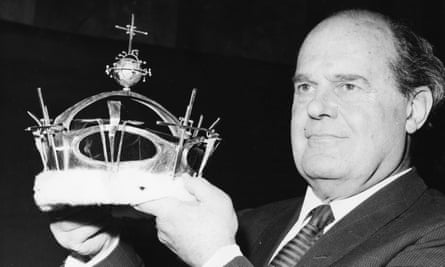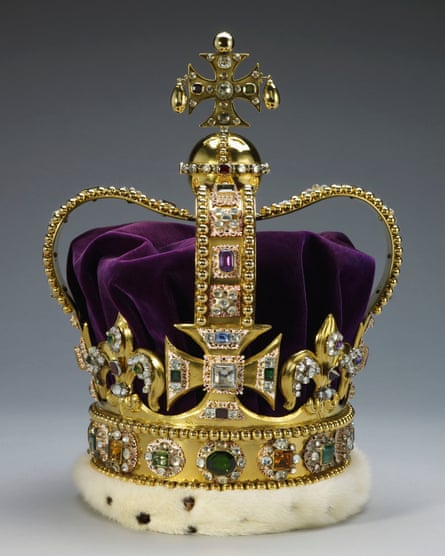When King Charles was invested as the Prince of Wales in 1969, the young royal went through all the pomp and ceremony unaware that the jazzy modern crown he wore on his head was topped with a ping-pong ball. The plastic sphere was, of course, well disguised: not only coated with gold filigree but also surrounded by a floating constellation of diamonds arranged in the shape of Charles’s star sign, Scorpio. It was pagan astrology meets high church meets high camp, a fittingly fruity headpiece for the eccentric prince.
The crown was designed by Louis Osman, an architect and goldsmith described by one of his friends as “the original hippie” – and it marked a radical departure from the usual staid royal headwear. This was a futuristic vision featuring swooping golden arches surrounded by abstract fleurs-de-lis and needle-thin crosses that jutted out like splintering lightning bolts. The gold, symbolically, came from a Welsh nugget, but rather than being traditionally hammered it was – in a showcase of modern methods – electroplated on to an epoxy resin cast. An internal purple velvet cap banded with ermine completed the look, fulfilling Charles’s wish for a crown that could be worn by a “modern prince” with a regular haircut, not someone with a wig, and “ears that show”.
The curious coronet was the centrepiece of an elaborate ceremony concocted for the TV age by Charles’s media-savvy uncle, the photographer Lord Snowdon. The 20-year-old prince was crowned against the dramatic medieval backdrop of Caernarfon Castle, beneath a swooping perspex canopy, designed so cameras could get a good view of the action, while guests sat on modern red-stained bentwood chairs, adding a bit of Technicolor pop to the scene. The ceremony itself was mostly invented. As Snowdon later recalled, it was “all as bogus as hell”.

Half a century on, the design-conscious king is now preparing for the most momentous ceremony of his life. This time, it is a genuine 1,000-year old rite, barely altered since the 11th century, and unlikely to feature swooping perspex or experimental lightning bolt headgear. Charles III’s alternative leanings seem to still run strong, though: the coronation invitations featured the leafy visage of the Green Man surrounded by a fecund border of pre-Christian motifs. But, sadly, Charles won’t be crowned with a druidic wreath.
Instead, two other historic headpieces will take centre stage. The coronation itself will use the St Edward’s crown, made in 1661 for Charles II and used by Queen Elizabeth II in her royal insignia – its familiar silhouette is emblazoned on postboxes up and down the country (and is now available as a £24 bauble from John Lewis). This headpiece is modelled on an 11th-century crown said to have been worn by Edward the Confessor – a claim most likely fabricated by the monks of Westminster Abbey to attract pilgrims. Their ploy worked and that crown was used in the coronation of every English monarch for the next 400 years.
It met a sticky end in 1649, though, following the execution of Charles I during the English civil war, when the House of Commons voted to melt down the “toys and trifles” of the monarchy. The parliamentarians weren’t impressed by such ancient bling. Their inventory simply states: “Crowne of gould wyer-worke sett with slight stones, and two little bells.” Ripe for the furnace!
With just that scant record to go on, the 17th-century crown that will be used this weekend is a florid fantasy of what that melted crown might have been, conjured by royal jeweller Robert Vyner with a liberal dollop of artistic licence. It features hefty double arches of solid gold fringed with gold beads and set with tourmalines, white and yellow topazes, rubies, amethysts, sapphires, garnet, peridot, zircons, spinel and aquamarines, step-cut, rose-cut and mounted in enamelled gold collets – all coming in at more than 2kg of glitz. “It weighs a ton,” the late Queen once complained. According to Private Eye, Charles has been preparing by wearing bags of flour on his head, wrapped in velvet and concealed inside a bowler hat.

St Edward’s crown wasn’t always so bejewelled. In an echo of today’s austerity, it was left gem-less most of the time as a cost-saving measure. “Until the 20th century, they used to rent the jewels for the coronation,” says Anna Keay, author of The Crown Jewels, a definitive history. “Before the deep mining of monster diamonds got going in South Africa, there weren’t many around. So the royal jeweller would hire them from people who had pieces in their collections.” Renting the gems meant the crown could be blinged-up beyond what the royal coffers could otherwise afford. As the crown jewellers pointed out to George IV in 1820, if the stones were hired, his crown could be made “to any expense”.
Charles III may wish he still had the power to spruce up the family heirloom with a few iced-out scorpions. Instead, his coronation will see St Edward’s crown immortalised as an emoji. Not that the king seems particularly fond of his mother’s headpiece: he has already removed it from the royal cypher, going back to the Tudor crown instead. This 3kg monster – made for Henry VIII and also melted down in the civil war – was modelled on nothing less than the Imperial Crown of the Holy Roman Empire. One wonders whether Charles lobbied for this lost headpiece to be recreated for his coronation – perhaps in fibreglass, like the rooftop finials of Poundbury, his model town.
Anyway, the king won’t have to wear St Edward’s crown for long. At a certain moment, Charles will withdraw into St Edward’s chapel and re-emerge like a pimped-up butterfly, sporting regal purple robes and new headwear: the imperial state crown. At less than half the weight of St Edward’s, it is the more practical of the two, worn at the state opening of parliament and other such jamborees. But its lightness belies the bedazzle. When the original imperial crown was destroyed in 1649, it was valued at five times that of St Edward’s because of all its jewels – and the 1937 recreation doesn’t hold back.
“It’s completely encrusted,” says Keay. “You can’t even see the crown for the diamonds.” There are almost 3,000, along with 17 sapphires, 11 emeralds, 269 pearls and four rubies, including the Black Prince’s ruby, a wonky cabochon spinel that looks like a squashed glacé cherry.
As the name implies, the imperial crown is the ultimate symbol of Britain’s colonial era: a hat-sized monument to forcible resource extraction. Pride of place is the 317-carat Cullinan II diamond, one of several stones cut from the gigantic 3,000-carat Cullinan diamond mined in South Africa in 1905, when the country was a British colony. The symbolism did not go unnoticed when the crown appeared at the Queen’s funeral, sparking calls for repatriation of the stones.

“The minerals of our country and other countries continue to benefit Britain at the expense of our people,” said Thanduxolo Sabelo, former provincial secretary for the ANC, South Africa’s ruling party. “The Cullinan diamond must be returned with immediate effect.” The Royal Collection Trust, which looks after the crown jewels, contends the Cullinan stone “was presented to Edward VII in 1907 as a symbolic gesture to heal the rift between Britain and South Africa after the Boer war”.
The Queen’s death also triggered calls for the return to India of the Koh-i-noor diamond, the infamous blood-drenched jewel currently fixed to the Queen Mother’s crown, over which Iran, Afghanistan and Pakistan also have claims. That crown would have been the default choice for Camilla, the Queen Consort, but it will remain locked up in the Tower of London for the coronation after India’s ruling party let it be known that its appearance would bring back “painful memories of the colonial past”. Instead, Camilla will don Queen Mary’s crown, designed in 1911 as an adaptable crown for multiple occasions, complete with removable arches, so it could be worn as a “circlet”, and detachable diamonds that could be worn as brooches.
“If you’re a crown-spotter it looks very European,” says Keay, explaining how thge headpiece features eight half-arches rather than the usual four. “For Camilla, they’re removing some of the arches to make it look more English. But even so, it’s a socking great bit of Edwardian kit. I hope she’s got a nice big head.”
Previous consorts have always had a new crown commissioned, but Buckingham Palace is keen to emphasise the decision to recycle one from the family’s sprawling collection “in the interests of sustainability and efficiency”. Does this mean the age of great British crown design, after centuries of adorning gilded headwear with gems of dubious origin, is no more? “The king,” says Keay, “is more interested in aesthetics and craftsmanship than any royal in living memory. So if no new crown is being made for him, it’s hard to imagine a new crown in future.”
It seems that a millennium of regal headwear reached its majestic conclusion with that astrological ping-pong ball. An apt symbol of the monarchy, perhaps: a hollow plastic orb wrapped in a sparkly veil of hokum.
